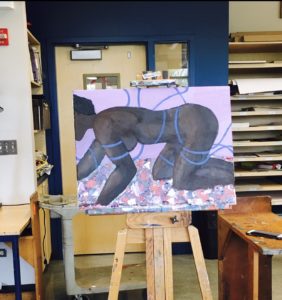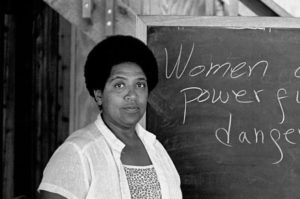From This Bridge Called My Back, Writing By Radical Women Of Color, Cherrié Moraga writing a letter to Barbara Smith about Moraga’s experience at an Ntozake Shange concert:
“There, everything exploded for me. She was speaking a language that I knew—in the deepest parts of me—existed, and that I had ignored… What Ntozake caught in me is the realization that in my development as a poet, I have, in many ways, denied the voice of my brown mother—the brown in me. I have acclimated to the sound of a white language which, as my father represents it, does not speak to the emotions in my poems….The reading had forced me to remember that I knew things from my roots… I knew that then, sitting in that Oakland Theatre (as I know in my Poetry) the only thing worth writing about is what seems to be unknown and therefore fearful (Cherrié Moraga, 31)”
I think that this reading really tied together a lot of moving parts I have been negotiating in our class. For my post I’d like to facilitate a sort of close read of this quote and connect it to some other parts of our assignment for this week as well as the preceding assignments we have had this semester.
Of course it is important to recognize that centrally this quote by Cherrié Moraga, co-editor of This Bridge Called My Back (This Bridge), is speaking directly to the subject of our study, Ntozake Shange. Moraga goes to an Shange concert and is moved. Moraga talks about this movement as something that comes from the “deepest parts” of her, from her “roots” —the way the comment is framed makes me understand that roots and deepest parts simultaneously have to do with the literal deepest parts of her psychic self and also from the roots that constitute her mother and aunts, and perhaps her ancestors.
This brought up for me, the content of “For the Color of My Mother” an essay that opens This Bridge by Moraga. In the poem, Moraga speaks of a dream she has in which her mother’s head is being passed around a circle of brown women. To me, based on the way the essay/poem is crafted, it tells me that the dream may have been about the responsibility of birthing into the world what only a brown girl can. It was about rupture and the need to make what spills from that rupture be something that can combat the silencing of brown women globally. It is a responsibility that does not come out of nowhere, it comes from her mother, it comes from her roots.
What spills from that rupture, that combats the silence, may in fact be Moraga’s own voice which she says she denied from her brown mother, her brown self. What follows this comment is the idea that she had only claimed the white language from her father and that she needs to pick up the brown poetic language of her mother. This reminded me of the way that Audre Lorde constructs the idea of the“white father who:
- tell us to “rely solely upon our ideas to make us free”
- “distorted” poetry into “sterile word play”… “in order to cover their desperate wish for imagination without insight.”
- “told us, I think therefore I am”
In “Poetry is not a Luxury”, Lorde writes of this figure in contrast to “the black mother in each of us” aka, “the poet” in each of us who “whispers in our dreams, I feel therefore I can be free”. This part of “Poetry is Not A Luxury”, helped me frame and understand Moraga’s comment that the white language her father gave her cannot “speak to the emotions in her poems”.
Finally, I’d like to look at the last segment of the quote that says that the real need in her poetry is to explore things that are unknown and fearful. This reminded me of Shange’s quote in Language & Sound where she writes: “The catastrophe of ignoring the unfamiliar, the exiled, the forgotten, is more than a bit of wrestling with “something missing”, it is the terror of becoming the embodiment of our own folklore set in time, and not defined by our own terms” (133). I think ideally this is a quote by Shange that I would like to continue to explore over the remainder of the semester because it really speaks to the politics of fear that I am interested in in Shange’s work and it also speaks to the idea the importance of self definition in a country, in a language, that has historically worked to render us silenced and a mere caricature of ourselves. It also helps me think about the stakes of the project that we are engaging in, of attempting to write and record and archive the truth of our lives and our connections to each other, so that they don’t become distorted by a culture dominated by white supremacy, so that they don’t become distorted by a university dominated by whiteness.
And to connect it to the separate piece we read for class today, “The Digital Afterlives of This Bridge Called My Back: Woman of Color Feminism, Digital Labor, and Networked Pedagogy” I think I’d like to think momentarily about the pedagogical framework that This Bridge provides the reader with, it is a pedagogy through which the reader and educators can develop their own strategies for growing and helping others grow. If we observe fully the tenants expressed in the essays and poems in the book, how does that change regular and normative curriculum plans and the pedagogical approaches of a given class or social circle? I think I have seen classes function that propagate the pedagogical reference points brought to bear in This Bridge and those classes have without fail changed my life. I wonder how those classes in the past and how this class now are changed by bringing the pedagogy of This Bridge into the digital sphere?
I’d like to leave the comment with a picture. Below you will find a picture I took of a painting I painted my senior year of high school in 2016 after reading through This Bridge for the first time. I was moved and spinning with information and poetry and truly, I was moved beyond words. I knew that I had to figure out how to embody what I had felt and what I was processing someway and I chose an acrylic medium to express the movement I was experiencing:

May 20, 2016 Chicago, IL
Painting based off of the cover of the original This Bridge Called My Back by Johnetta Tinker.



